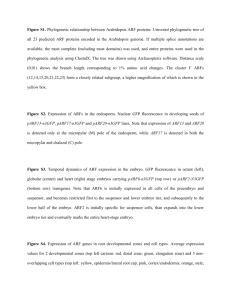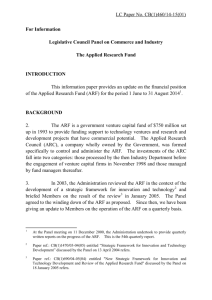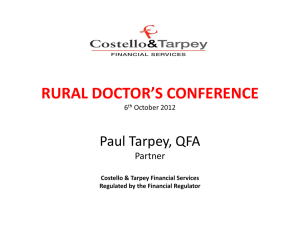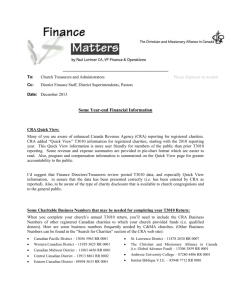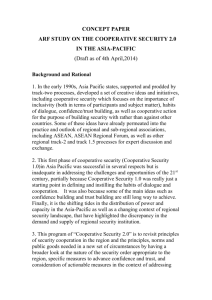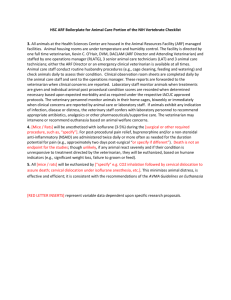CHAPTER 23 APPROVED RETIREMENT FUNDS Introduction 23.1
advertisement
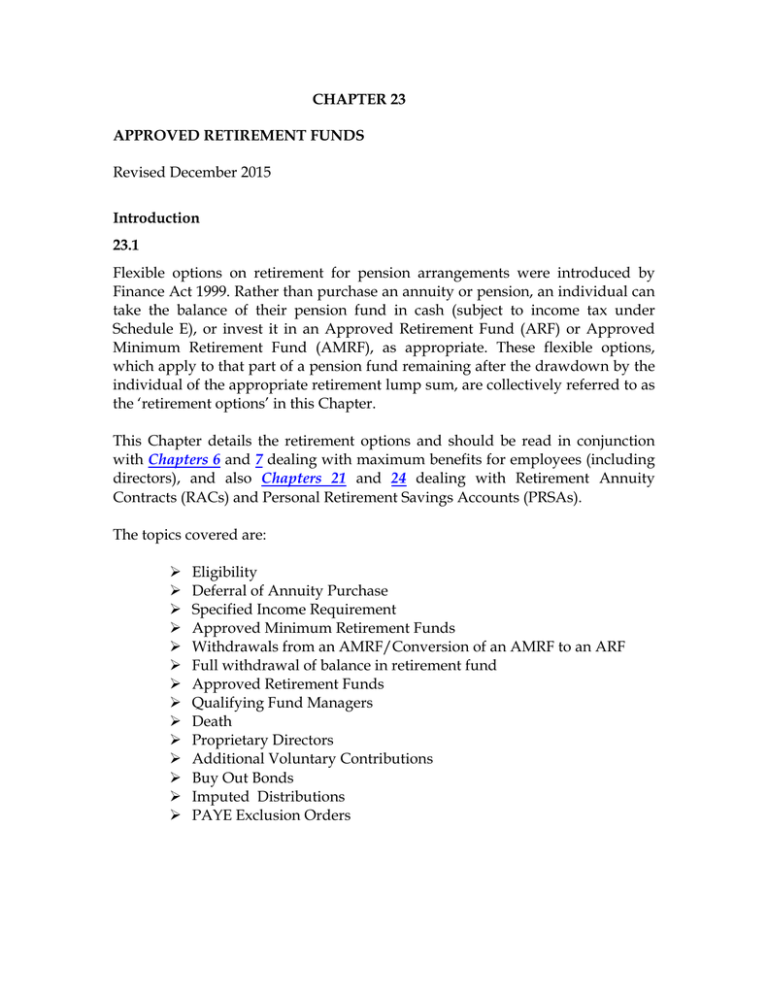
CHAPTER 23 APPROVED RETIREMENT FUNDS Revised December 2015 Introduction 23.1 Flexible options on retirement for pension arrangements were introduced by Finance Act 1999. Rather than purchase an annuity or pension, an individual can take the balance of their pension fund in cash (subject to income tax under Schedule E), or invest it in an Approved Retirement Fund (ARF) or Approved Minimum Retirement Fund (AMRF), as appropriate. These flexible options, which apply to that part of a pension fund remaining after the drawdown by the individual of the appropriate retirement lump sum, are collectively referred to as the ‘retirement options’ in this Chapter. This Chapter details the retirement options and should be read in conjunction with Chapters 6 and 7 dealing with maximum benefits for employees (including directors), and also Chapters 21 and 24 dealing with Retirement Annuity Contracts (RACs) and Personal Retirement Savings Accounts (PRSAs). The topics covered are: Eligibility Deferral of Annuity Purchase Specified Income Requirement Approved Minimum Retirement Funds Withdrawals from an AMRF/Conversion of an AMRF to an ARF Full withdrawal of balance in retirement fund Approved Retirement Funds Qualifying Fund Managers Death Proprietary Directors Additional Voluntary Contributions Buy Out Bonds Imputed Distributions PAYE Exclusion Orders Eligibility 23.2 The retirement options are available only to certain individuals who commenced to take retirement benefits after 2 December 1998. They apply at retirement only and do not apply to death in service benefits. The retirement options are available to: All holders of Retirement Annuity Contracts set up after 6 April 1999 and, in certain circumstances, they may also be offered to holders of contracts established prior to that date. Members of Retirement Annuity Trust Schemes approved under section 784(4) TCA 1997. Holders of PRSAs. All members of defined contribution (DC) schemes and members of defined benefit (DB) schemes who are proprietary directors, in respect of their accrued benefits from 1. the scheme, including contributions (AVCs), or 2. AVCs only. benefits from additional voluntary Members of DB schemes who are not proprietary directors in relation only to pension benefits arising from their AVCs. The spouse or former spouse, or (with effect from 27 July 2011) civil partner or former civil partner of all members of DC or DB schemes where there is a pension adjustment order. (Where the member of a DB scheme is not a proprietary director, the ARF option applies only to benefits arising from AVCs). (Please refer to paragraph 23.12 for additional information on AVCs) Notes Prior to 6 February 2011 only proprietary director members of retirement benefits schemes (and their spouse or former spouse) could avail of the retirement options in respect of all of their benefits (whether from a DB or DC scheme). Other members of such schemes (again whether DB or DC schemes) could avail of the options in respect of benefits arising from AVCs only. In relation to DC schemes, the retirement options apply to the main benefits from schemes approved on or after 6 February 2011 and from schemes in existence prior to that date where the scheme rules are amended to allow the exercise of the option. Where an individual opts for the retirement options (other than an individual who opts only in respect of his or her AVCs) the value of the lump sum that he or she can take in part commutation of pension can not exceed 25% of the value of the pension fund. All individuals wishing to avail of the retirement options must satisfy the specified minimum income requirement detailed in paragraph 23.4. The option to purchase an annuity at retirement remains. Holders of more than one RAC may exercise a different option in respect of each contract. Similarly, holders of more than one PRSA may also exercise a different option in respect of each contract. Members of multiple occupational pension schemes relating to the same employment must exercise the same option in respect of each scheme. However, as noted above, an individual may exercise a different option in relation to AVC funds than that made in respect of their main occupational pension scheme benefits. Proprietary director means a director who, either alone or together with his or her spouse, civil partner and minor children or the minor children of the civil partner is or was, at any time within 3 years of the date of (i) (ii) (iii) (iv) The specified normal retirement date, An earlier retirement date, where applicable, Leaving service, or In the case of a pension or part of a pension payable in accordance with a pension adjustment order, the relevant date in relation to that order, the beneficial owner of shares which, when added to any shares held by the trustees of any settlement to which the director or his or her spouse or civil partner has transferred assets, carry more than 5 per cent of the voting rights in the company providing the benefits or in a company which controls that company. AVCs mean voluntary contributions made to a scheme by an employee which are (i) (ii) Contributions made under a rule or part of a rule, as the case may be, of a retirement benefits scheme (in this definition referred to as the “main scheme”) which provides specifically for the payment of members’ voluntary contributions, other than contributions made at the rate or rates specified for members’ contributions in the Rules of the main scheme, or Contributions made under a separately arranged scheme for members’ voluntary contributions that is associated with the main scheme. Deferral of Annuity Purchase 23.3 Under the deferred annuity purchase option introduced by the Minister for Finance on 4 December 2008, a member of a DC scheme who retired on or after that date, and who would otherwise have been compelled to purchase an annuity, was allowed to postpone the purchase of an annuity until 31 December 2010. That deadline was further extended to 5 March 2011. Individuals who postponed the purchase of an annuity and who wished to avail of the ARF option following the amendment of the rules of their former DC scheme to allow for the option had until 5 March 2011 in which to do so. Please refer to Revenue e-Brief No. 65/08 of 22 December 2008 for further details. Specified Income Requirement 23.4 An individual wishing to have the balance of their pension fund, after taking any retirement lump sum, paid to them or transferred to an ARF, must, if under 75 years of age, have a minimum guaranteed annual pension income (“specified income”) for life in payment at the time an ARF option is exercised in order to avoid having to go the AMRF or annuity route. The specified income amount is currently €12,700. For ARF options exercised on or after 6 February 2011 and before 27 March 2013 (the date of passing of Finance Act 2013) the specified income requirement had been increased from €12,700 per annum to an amount equal to 1.5 times the maximum annual rate of State Pension (Contributory) (rounded up or down to the nearest €100), which during that period was €18,000. However, the previous lower limit of €12,700 was reinstated for ARF options exercised on or after 27 March 2013 and it was intended that the lower limit would remain in place for a period of 3 years, whereupon the higher limit implemented on 6 February 2011 would be reapplied by legislation1. As Finance Act 2015 does not provide for the re-instatement of the higher limit, the lower limit of €12,700 continues to apply. Specified income is a pension or annuity (including Social Welfare pensions2 and overseas pensions) which is payable for the life of the individual and must be in payment at the date of exercise of the ARF option. For example, an individual retiring at age 60 could not include a Social Welfare pension payable from age 66 as specified income at the time of retirement. Pensions paid directly to an individual’s spouse or civil partner or pensions/allowances received on behalf of a spouse, civil partner or dependant may not be taken into account in computing that individual’s specified income. Approved Minimum Retirement Fund (AMRF) 23.5 Where the specified income requirement is not satisfied in the case of an individual aged under 75, he/she must, after taking a retirement lump sum, transfer the lesser of the balance of the pension fund or €63,500 to an AMRF or use it to purchase an annuity (or a combination of both). For ARF options exercised on or after 6 February 2011 and before 27 March 2013 (the date of passing of Finance Act 2013), the amount to be transferred to an AMRF had been increased to an amount equal to 10 times the maximum annual prevailing rate of State Pension (Contributory) (rounded up or down to the nearest €100), which during that period was €119,800. However, the previous lower amount of €63,500 was reinstated for ARF options exercised on or after 27 March 2013. As is the case with the specified income requirement, it was intended that this lower amount would remain in place for a period of 3 years, whereupon the higher amount implemented on 6 February Please refer to paragraph 23.6.1 for details of measures that may be relevant to individuals who were subject to the higher specified income and AMRF requirements in the period 6 February 2011 to 26 March 2013. 2 Within the scope of the Social Welfare Consolidation Act 2005 (No. 26 of 2005) 1 2011 would be reapplied by legislation (please refer to footnote 1). As Finance Act 2015 does not provide for the re-instatement of the higher amount, the lower amount of €63,500 continues to apply. Where an individual exercises a sequence of ARF options in relation to separate pension benefit schemes, the maximum amount that has to be placed in an AMRF or used to purchase an annuity in respect of all such schemes is €63,500 or, where the maximum amount is calculated by reference to the maximum annual rate of the State Pension (Contributory), the rate that applies at the date each option is exercised. The following general points should also be noted: An individual cannot have more than one AMRF at any one time. However, all assets in an AMRF may be transferred from that AMRF to another AMRF. An AMRF may not be used as security for a loan. AMRF funds may be used to purchase an annuity for the beneficial owner at any time. Similar operating and administrative provisions apply for AMRFs as apply for ARFs (see paragraph 23.8). There is no provision for an apportionment of the maximum amount that must be placed in an AMRF or used to purchase an annuity where an individual partially meets the specified income requirement. For example, an individual who has specified income of €6,350 p.a. (at a time when the specified income requirement is €12,700) must still place €63,500 or the fund balance, if lower, in an AMRF rather than half of that amount (on the basis that they satisfy half the specified income requirement). Withdrawals from an AMRF/Conversion of an AMRF to an ARF 23.6 Section 19(2)(b) Finance Act 2014 introduced a measure, effective from 1 January 2015, which allows for the payment or transfer on one occasion only in any tax year of up to 4% of the value (at the time of the payment or transfer) of the assets in an AMRF to the AMRF owner. Any amount paid or transferred to the owner is taxable in the same manner as a distribution from an ARF (see paragraph 23.8). Please refer to paragraph 23.15 regarding the issue of PAYE Exclusion Orders. Prior to 1 January 2015, the initial capital transferred into an AMRF could not be withdrawn other than to purchase an annuity, which meant that only the income or gains of an AMRF could be paid or transferred to the AMRF owner, subject to tax. An AMRF automatically becomes an ARF where an individual: attains the age of 75 years, acquires the required level of specified income, having previously placed funds in an AMRF because the specified income test was not met when the ARF option was exercised (please refer to paragraph 23.6.1), or dies. Transitional arrangements 23.6.1 Section 17(6) Finance Act 2013 introduced measures to ensure that individuals who were subject to the higher specified income and AMRF limits which applied during the period 6 February 2011 to 26 March 2013 were not disadvantaged (see paragraphs 23.4 and 23.5). Firstly, where such individuals have guaranteed annual pension income of at least €12,700 on or after 27 March 2013 (the date of passing of Finance Act 2013) any AMRF immediately becomes an ARF. Secondly, where they do not have guaranteed annual pension income of €12,700 on 27 March 2013 but had originally transferred more than €63,500 to an AMRF, the excess amount transferred above €63,500 immediately becomes an ARF. Pension and Property Adjustment Orders 23.6.2 A transfer from an ARF or AMRF into another ARF/AMRF in the name of a spouse or civil partner in exercise of rights under a Pension or Property Adjustment Order will not be regarded by Revenue as a distribution from the transferring ARF/AMRF. In both scenarios the recipient spouse or civil partner may open an ARF/AMRF to facilitate the transfer notwithstanding that he or she may not, strictly speaking, have that option under Part 30 of the TCA 1997. For further information on Pension Adjustment Orders please refer to Chapter 22. Full withdrawal of balance in retirement fund 23.7 Provided the individual has satisfied the specified income or AMRF/annuity requirements (see paragraphs 23.5 and 23.8), the balance of the retirement fund, after any amount taken as a retirement lump sum, may be paid to the individual. This amount is treated as emoluments of the individual and is taxable under Schedule E. The person making the payment (Life Office or Scheme administrator) is deemed to be an employer for all obligations under the TCA 1997. Life Offices and Scheme Trustees should record the following details of individuals availing of this option: name, address, PPS number, amount withdrawn. Please refer to paragraph 23.15 regarding the issue of PAYE Exclusion Orders. Approved Retirement Fund (ARF) 23.8 As an alternative to full fund withdrawal, an individual who has satisfied the specified income or AMRF requirements may transfer the balance of the retirement fund, excluding any amounts taken as a retirement lump sum to an ARF. The Life Office or Scheme Administrator should pay any retirement lump sum to the individual prior to transferring the balance of the fund to an ARF. The funds in the ARF remain the property of the individual who is the beneficial owner and may be withdrawn at any time. Income and gains of ARF funds are exempt from tax while retained in the ARF. An amount withdrawn from an ARF, including an imputed amount (see paragraph 23.14 and Chapter 28), is referred to as a “distribution”. A distribution has a very wide meaning and encompasses any payment or transfer of assets out of an ARF, or the assignment of the ARF, or assets in the ARF, by any person, including a payment, transfer or assignment to the person beneficially entitled to the assets. It does not, however, include the transfer of assets to another ARF owned by the individual or to the transfers described in paragraph 23.6.2. Without prejudice to the generality of the definition of the term “distribution”, the following are specifically regarded as distributions by virtue of section 784A(1B) TCA 1997: Loans made to the beneficial owner or connected person, or the use of the assets of an ARF as security for such a loan, Acquisition of property from the beneficial owner or connected person, Sale of an ARF asset to the beneficial owner or connected person, Acquisition of residential or holiday property for use by the beneficial owner or connected person, Acquisition of property which is to be used in connection with any business of the beneficial owner, or of a connected person, Acquisition of shares in a close company in which the beneficial owner, or connected person, is a participator, The use of ARF assets by an ARF owner to invest in any fund, trust or scheme etc. where a pension arrangement of a person connected with the ARF owner (for example, an adult child, spouse etc.) invests in the same, or any other, fund, trust or scheme etc. and there is an arrangement whereby the investment return to the pension arrangement is attributable in any way to the investment by the ARF owner (for example, any remaining income or capital in the fund reverts to the pension arrangement on the death of the ARF investor or otherwise on the winding up of the fund). (Where a distribution arises in these circumstances, section 790E provides that the connected person’s pension arrangement is chargeable to income tax under Case IV of Schedule D on any income or capital gains arising to the arrangement from the investment in the fund etc.). In the case of property acquisition, the distribution is the amount of the value of the ARF assets used in connection with the acquisition, improvement and/or repair of the property. A close company means a company under the control of 5 or fewer participators, or of participators who are directors. Please refer to section 430 TCA 1997 for a complete definition. A participator in relation to any company, means a person having a share or interest in the capital or income of a company. Please refer to section 433 TCA 1997 for a complete definition. Definitions of “connected persons” and “relative” are contained in section 10 TCA 1997. Any distribution in relation to an ARF is deemed, for the purposes of section 784A, to have been made by the QFM. A distribution is treated as a payment of emoluments to which Schedule E applies. However, the following are not taxable distributions– A distribution from an ARF which is used to reimburse a pension scheme administrator for tax paid by that administrator on a chargeable excess (see Chapter 25.6) relating to the ARF holder. Where a benefit crystallisation event (BCE) giving rise to chargeable excess tax occurs in respect of retirements benefits which are the subject of a pension adjustment order (PAO), a distribution from an ARF of the nonmember spouse or partner for the purposes of paying his or her share of the chargeable excess tax arising on the BCE, or a part of it. Certain distributions arising following the death of the ARF owner (see paragraph 23.10). Please refer to paragraph 23.15 regarding the issue of PAYE Exclusion Orders. An individual may have more than one ARF. Transfers may be made from one ARF to another ARF but may not be made from a post-April 2000 ARF to a pre-April 2000 ARF. ARF funds may be used at any time to purchase an annuity payable to the beneficial owner. The annuity purchase is not a distribution. However, the purchase of an annuity for any other person is treated as a distribution. Qualifying Fund Manager (QFM) 23.9 An ARF or AMRF must be managed by a QFM. A QFM is defined in section 784A TCA 1997 as one of the following: Bank Building society Trustee savings bank Post office savings bank Credit union Collective investment undertaking (e.g. unit trust) Life assurance company Stockbroker Certain authorised investment intermediaries The QFM has complete responsibility for the discharge of all obligations in relation to tax due on all distributions from the ARF and, as the case may be, AMRF in question. A QFM who is not resident in the State, or who is not trading in the State through a fixed place of business, may appoint a resident administrator to take responsibility for the obligations imposed by the Taxes Acts. If a resident administrator is not appointed, a QFM, resident in another EU Member State, must enter into a contract with Revenue agreeing to discharge all legislative obligations imposed on the QFM. A QFM must advise Revenue of the intention to act as a QFM within one month of commencing to act in that capacity. Prior to the establishment of an ARF or an AMRF, the QFM must receive a declaration from the beneficial owner and a certificate from the Life Office, Scheme Administrator or PRSA Provider. This information is also required where there is a transfer from one ARF to another. The declaration should contain the following: Name, address, tax reference number of the beneficial owner. Confirmation that the assets which are to be transferred consist only of assets to which the individual is beneficially entitled, and Confirmation that the assets which are to be transferred are currently held in an RAC, PRSA, or an exempt approved occupational pension scheme. The policy number and name of the Life Office/Provider or the name and Revenue reference number of the scheme should be stated. If the declaration refers to the establishment of an ARF, it must also provide detailed confirmation that the AMRF requirements have been met or that the beneficial owner is in receipt of the specified income. It is necessary to state the name and reference number of the QFM who manages the AMRF, details of any annuity purchased, or the name and reference number of the person paying the specified income. Death 23.10 Any payment, or imputed payment, from the ARF is a distribution and is taxable as such. The amount of the distribution is treated as income of the ARF owner for the year of assessment in which that individual dies. There are some exceptions: A transfer to an ARF in the name of the deceased’s spouse or civil partner is not a distribution. A transfer to a child of the individual under 21 is not a distribution. However, a distribution made to a child aged 21 or over from: the ARF of the deceased, or an ARF in the name of a surviving spouse or surviving civil partner funded by the ARF of the deceased spouse or civil partner, is subject to an income tax charge under Case IV of Schedule D at the rate of 30% (which is a ring-fenced final liability tax). Case IV tax deducted by a QFM from this type of distribution is subject to the reporting and collection provisions applying to the excess lump sum tax regime (see Chapter 27). Prior to 31 March 2012, the rate of charge was the standard rate and the tax was collected under the PAYE regime. The position regarding Income Tax & Capital Acquisitions Tax on the death of the ARF holder and on the subsequent death of the spouse/civil partner into whose ARF the original ARF was transferred is summarised below. The usual CAT thresholds apply: Beneficiary Spouse/civil partner Child under 21 Child over 21 Others Death of Holder Income Tax No CAT No No Yes Yes Yes No Yes Death of Partner Income Tax Spouse/Civil CAT No Yes Yes Yes No Yes Proprietary Directors 23.11 The options outlined in this chapter are available to proprietary directors (also referred to as ‘5% directors’) regardless of whether the scheme is a DC or DB scheme. A 5% director wishing to exercise one of the retirement options is still subject to the usual funding and contribution rules. A maximum benefits test should take place at retirement and retirement options are based on the fund determined by the maximum benefits test. A 5% director taking one of the options may take a retirement lump sum of up to 25% of the value of the retirement fund. This replaces the amount that is calculated by reference to final remuneration and years of service (see Chapter 7). All schemes for proprietary directors approved since 6 April 1999 must offer the retirement options. Where a 5% director exercises a retirement option, he/she must exercise the same option in relation to all schemes from the same employment. A retirement option may be exercised on early retirement. An option may only be exercised when benefits are taken. Where a 5% director reaches NRA and continues working but takes benefits at NRA and is eligible to take further benefits on actual retirement at a subsequent date, the benefits must be of the same type as those taken at NRA. Additional Voluntary Contributions 23.12 Please refer to paragraph 23.2 which clarifies what contributions qualify for the retirement options. The definition of an AVC excludes employee contributions if such employee contributions are matched by employer contributions. This means that members of DC or DB schemes cannot choose to transfer only their AVCs benefits to an ARF where their AVC contributions are matched by employer contributions. However, in the case of a DC scheme, the transfer to an ARF of pension rights accruing to an individual from AVCs where there are matching employer contributions is permitted where the individual transfers all of his/her accrued rights (i.e. from both the main scheme and AVCs) into an ARF at the same time. The retirement lump sum calculation used where a retirement option is exercised in respect of AVCs only continues to be on the 3N/80th basis as outlined in Chapter 7. Buy-Out Bonds 23.13 Revenue eBrief No. 72/11 dated 28 November 2011 confirmed, in the case of BuyOut Bonds (BOBs), that access to the retirement options followed on from the options available in respect of main scheme benefits under the occupational pension scheme arrangement from which the transfer value originated. The position set out in the eBrief can be summarised as follows: Defined Benefit (DB) Schemes: The ARF option is available in respect of transfer values from DB occupational schemes to a BOB where the scheme member has the right to exercise the option under the scheme rules prior to the date of transfer i.e. he or she meets the proprietary director test before the date of transfer. Any other main scheme transfers to a BOB from a DB scheme do not attract the ARF option. Defined Contribution (DC) Schemes: The ARF option is available in respect of transfer values from DC occupational schemes: where the scheme member meets the proprietary director test before the date of transfer, and in any other case, where the transfer takes place on or after 6 February 2011 and the scheme rules have been amended to provide for the option before the date of transfer. The position outlined above in respect of DC Schemes meant that main scheme transfers to BOBs from DC schemes before 6 February 2011 (other than in the case of proprietary directors) did not attract the ARF option. However, with effect from 26 May 2014, Revenue will allow access to the “ARF option” in respect of main scheme transfers to BOBs from DC schemes regardless of when the transfer occurred. The position as respects main scheme transfers to BOBs from DB Schemes, summarised above, remains unchanged. Imputed Distributions 23.14 The following describes the imputed distribution regime which applied for all years to 31 December 2011 in respect of assets held in an ARF. For the year of assessment 2012 and following years, a new regime applies and provides for imputed distributions for both ARFs and vested PRSAs on a composite basis. Please refer to Chapter 28 for further details. An imputed distribution on the market value of assets held in an ARF on the specified date (31 December each year) has applied since 2006. The scheme, as introduced, provided for a 3% distribution on the market value of such assets, phased in over a three year period, with a rate of 1% applying in 2007, 2% in 2008 and 3% in 2009. The rate applicable in 2010 and 2011 was 5%. QFMs were required to review all ARFs under their management each year to ascertain if an imputed distribution arose. When does an imputed distribution arise? An imputed distribution applies: for a year of assessment where the ARF owner is 60 years of age or over for the whole of that year, and in respect of ARFs created on or after 6 April 2000. The imputed distribution regime does not apply to AMRFs. How is the imputed distribution, if any, calculated? The imputed distribution is calculated as a percentage of the market value of assets in an ARF on 31 December each year (to 2011). In the case of buildings, where a valuation is not readily obtainable as at 31 December, it is acceptable to use a valuation at any date within 3 months prior to 31 December. Actual distributions made during the year, from the ARF or AMRF (in respect of income or gains) may be deducted from the “imputed distribution” to arrive at a “net” imputed distribution (if any). However, any amounts treated as distributions arising from certain transactions (section 784A(1B) TCA 1997), as detailed in paragraph 23.8, are not deductible for the purposes of the calculation. For the years of assessment 2010 and 2011, the formula used to calculate the imputed distribution was: (A × 5) 100 minus B where A is the value of the assets in the ARF (or ARFs) at 31 December in the relevant year and B is the value of any actual distributions made in that year. Examples: 1. Joe has an ARF valued at €600,000 at 31/12/2010. During the year of assessment 2010 the qualifying fund manager made distributions of €10,000 from his ARF. The amount of the imputed distribution based on the fund value at 31/12/2010 is calculated by using the formula, (A x 5) 100 minus B where A is €600,000 and B is €10,000 (€600,000 x 5) = €30,000 100 €30,000 minus €10,000 = €20,000, i.e. the amount of the imputed distribution for 2010. 2. Joan has an ARF valued at €400,000 and an AMRF valued at €63,500 at 31/12/2010 (The ARF was valued at €549,000 on 31 December 2009 and growth the following year was €5,000). During 2010 she received distributions of €2,000 from the AMRF and €4,000 from the ARF. On 30/06/2010 the ARF bought a holiday home for Joan’s personal use at a cost of €150,000. The amount of the imputed distribution based on the fund value at 31/12/2010 is calculated by using the formula, (A x 5) 100 minus B where A is €400,000 and B is €6,000 (€400,000 x 5) = €20,000 100 €20,000 minus €6,000 = €14,000, i.e. the amount of the imputed distribution. Notes Actual distributions are €6,000 (€2,000 plus €4,000) Although the cost of the holiday home is treated as a distribution (see paragraph 23.8), it can’t be included in the calculation of B (section 784A(1B)(d) TCA 1997) as an offset against the tax due. A is arrived at as follows: Value at 31/12/2009 Growth during 2010 Distributions during 2010 Asset disregarded under S784A(1D) Value at 31/12/2010 € 549,000 5,000 (4,000) (150,000) 400,000 More than one ARF The calculation of the imputed distribution for a year of assessment is based on the aggregate value of the assets in all ARFs, and the aggregate amount of distributions from all ARFs and AMRFs, that are beneficially owned by the individual. Where the ARF owner has more than one ARF, all of which are not managed by the same QFM, the ARF owner may nominate one of the QFMs for the purposes of operating these provisions and for accounting for any tax due on any overall imputed distribution. This arrangement is optional and there is no obligation on a QFM to accept such a nomination. Where a QFM agrees to act as the “nominee QFM”, the ARF owner must advise all the other QFMs involved of the name and address of the nominee, and the “other QFMs” must provide the “nominee QFM” with a certificate detailing the ARF asset values and actual distributions made by them. The “nominee QFM” must then calculate the imputed distribution as if the nominee had managed all of the ARFs and had made all of the actual distributions. Procedure for Payment of Tax The imputed distribution is to be regarded as a distribution made not later than February in the year of assessment following the year of assessment to which the imputed distribution relates. The QFM must deduct tax from the imputed distribution in accordance with the provisions of section 784A(3) TCA 1997. Tax deducted must be included in the QFMs P30 return submitted to Revenue not later than 14 March of that year. For example, in respect of an imputed distribution calculated for 2010, the tax must be paid by 14 March 2011. Details of the tax deducted should also be included in the annual P35 return due in February 2012. All payments of tax should be forwarded to: Office of the Revenue Commissioners Collector-General’s Division PO Box 354 Limerick The remittance should be accompanied by the following statement completed by the QFM. Approved Retirement Funds Name of QFM: Address: I confirm that all Approved Retirement Funds under management have been reviewed for the purposes of establishing if liability arises under Section 784A(3) TCA 1997. Arising from this review, a sum of € ___ is reflected in the P30 for (month) in respect of tax deducted from (insert number) Approved Retirement Funds, and is included in the remittance to the Collector General in respect of that month. Authorised Signatory: Date: A payment and return can be sent electronically using Revenue-On-Line (ROS). For details phone 1890 201106 or see the Revenue website: http://www.revenue.ie/en/online/ros/index.html. PAYE Exclusion Orders in respect of ARFs, AMRFs and retirement fund balances 23.15 Income and assets retained in an ARF (see paragraph 23.8) or an AMRF (see paragraphs 23.5 & 23.6) are beneficially owned by the ARF/AMRF owner. Distributions (including deemed distributions) from ARFs and AMRFs are treated and taxed as emoluments under Schedule E, regardless of the residence status of the individual. As Revenue’s position is that distributions from ARFs or AMRFs are not payments of pension, PAYE Exclusion Orders are not issued in respect of such distributions. For the sake of completeness, Revenue also confirms that PAYE Exclusion Orders are not issued where an individual takes the balance of his or her pension fund3 as a taxable lump sum (see paragraph 23.7). i.e. the balance of the fund after any retirement lump sum and, in circumstances where the specified income requirement is not satisfied (see paragraph 23.5), any amount which has been transferred into an AMRF or used to purchase an annuity. 3
